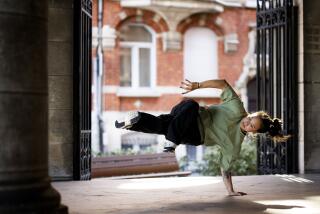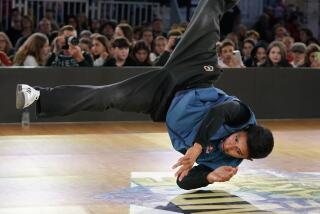Drug tests can be a bummer
ASPEN, COLO. — Shaun White slumps on a couch inside a cavernous chalet rented by one of his corporate sponsors. The millionaire snowboarder appears weary from a party thrown the previous night by another sponsor.
It’s Thursday afternoon and beyond the patio, on Aspen’s Buttermilk Mountain, the Winter X Games have begun.
White, 22, is two days from winning the popular slopestyle competition, and three days from repeating as halfpipe champion.
Deep in his mind, however, are the Winter Olympics, just one year away, and a stepped-up effort by the global drug police that runs counter to snowboarding’s long-cherished lifestyle and culture.
Asked how this might affect him, White pauses and responds, “Um . . . My biggest concern is getting around second-hand smoke,” and laughter fills the room. . . .
--
The Vancouver Olympics begin Feb. 12, 2010, but the long arm of Olympics law, operating under a retooled global anti-doping code, has been flipping through addresses for months.
Mason Aguirre, 21, recalls the rap on the door of his Mammoth Lakes home by a representative of the United States Anti-Doping Agency during the summer as he slept with his girlfriend.
“I wake up in a daze and have to wrap a towel around me, and I open my door and it’s like a 60-year-old dude,” Aguirre says. “And he’s like, ‘Hi, I’m Paul. I’m with USADA and I’m here to watch you pee in a cup.’ ”
Ellery Hollingsworth, 17, was most recently greeted outside her agent’s Carlsbad residence. She was ushered into the house and into the bathroom, asked to tuck the front of her shirt into her bra and fill a container.
“I was mortified for her,” says Susan Izzo, the agent.
Snowboarding has been an Olympic sport since 1998, and from the start the disconnect between the rigidity of the Olympic movement and a sport clothed in the counter-culture attire of free-spirited youth collided. In fact, the first gold medal ever awarded in snowboarding went to a Canadian shredder who later tested positive for marijuana.
And many snowboarders say the most recent set of drug-testing regulations for aspiring Olympians -- in which athletes must provide daily schedules for three-month periods at least 12 months before the start of the Olympics -- are an extension of an organization that is simply exerting too much control over their lifestyles. Those schedules must provide precise whereabouts for 60 minutes each day.
To be sure, the drug-testing protocol applies to all potential Olympic athletes, not just snowboarders. But other athletes, like Alpine skiers, are accustomed to being tested regularly because they compete in sanctioned events such as the World Cup and world championships. They’ve also long adhered to rigid training schedules.
Most snowboarders keep loose schedules and compete primarily in endemic events and high-profile contests such as the Winter X Games and the Dew Winter Tour, which concludes this weekend near Lake Tahoe. There is no drug testing at those events. The adjustment, understandably, isn’t going smoothly.
“When I leave Aspen on Monday and I go home, they know that,” Aguirre says. “And that kind of sketches me out.”
If an agent from USADA, the World Anti-Doping Agency or the International Skiing Federation (FIS), visits unannounced during the 60-minute window and the athlete is not present, it counts as a missed test.
Three infractions -- any combination of missed tests, failing to submit whereabouts information, or submitting inaccurate or incomplete whereabouts information -- could end an athlete’s chances to participate in the Vancouver Olympics.
Previously, out-of-competition testing involved unannounced visits, even during non-Olympic years, for most elite athletes. But if an athlete wasn’t home, he or she would receive a phone call and a meeting was arranged.
The 60-minute rule replaces the phone call. It went into effect Jan. 1 and is universal. All Olympic hopefuls are now on the testing radar screen, which seems reasonable -- unless you’re a snowboarder.
None of the top U.S. halfpipe riders compete regularly on the World Cup and only some compete on the FIS-sanctioned Grand Prix circuit, until the brief season immediately preceding an Olympics, when those events serve as qualifiers.
Halfpipe riders choose specific contests deemed most advantageous at a given time. Many do not know where they’ll be next week, much less three months ahead.
Like all athletes, they’re afforded the convenience of texting or phoning in changes to their schedules, on an almost up-to-the-minute basis. But that would require remembering what’s on the schedules they sent in. Some have already received strikes against them and more than a few are concerned about missing a chance at Olympic glory due to mere forgetfulness.
“We’re not at the gym, we’re on the mountain eight hours a day,” says Kelly Clark, the 2002 Olympic halfpipe gold medalist. “It’s very challenging for us because the rules are not adapted to our culture.”
Anti-doping officials maintain revisions in the code were designed to bring about uniform global compliance. Erin Hannah, a USADA spokeswoman, says rules “were carefully developed to strike a fair balance between potential inconveniences and safeguarding the rights of clean athletes worldwide.”
But the most critical among halfpipe riders -- and their managers and agents -- say the International Olympic Committee also strives to bring snowboarding under tighter control.
“It’s pathetic and it is so IOC,” says Izzo, whose agency represents several top snowboarders. “I could understand this if our athletes were using performance-enhancing drugs that would make them stronger or go higher in the pipe.
“But that’s not our sport, and if you know anything about action sports you know this lifestyle and this culture, and that’s not what these kids are doing on the side.”
A combustible situation
Snowboarders, with their deep-seeded anti-establishment roots, never were comfortable with authority, and veteran shredders surely recall snowboarding’s inauspicious Olympics debut at the 1998 Games at Nagano, Japan.
FIS told the budding International Snowboarding Federation it was taking charge, and Terje Haakonsen, at the time the world’s best snowboarder, called the IOC president a Nazi and snubbed the Olympics.
Canada’s Ross Rebagliati won the first Olympic snowboarding gold medal, then tested positive for marijuana, was stripped of the medal, and later had it restored when a court ruled the Olympics had no clear policy regarding marijuana. He famously claimed to have been a victim of second-hand smoke.
In reality, according to USADA chief executive officer Travis Tygart, the marijuana policy leading to the 2010 Vancouver Games is similar to what it was before the 2006 Turin Olympics. Pot is not tested for out-of-competition, but is prohibited in-competition during FIS-sanctioned events.
If an athlete tests positive for marijuana during a sanctioned competition, the issue comes under review. If two of three elements are met -- if pot was determined to have been performance-enhancing, posed a health or safety hazard, or violated the spirit of sport -- the athlete could be suspended and miss the Olympics.
“From an anti-doping standpoint, we do not want people using marijuana,” Tygart says. “Even out-of-competition, they need to make a decision that is in their best interest.”
For top halfpipe riders, from the U.S. anyway, an easy resolution is to steer clear of FIS-sanctioned events until the Olympic qualifying process requires attendance, mostly next winter. The X Games and Winter Dew Tour are not FIS-sanctioned and therefore are out-of-competition, so some riders may choose to soar higher than others, so to speak.
Although not all of them seem to realize this. Says Hannah Teter, the 2006 Olympic halfpipe gold medalist, on a perceived marijuana crackdown: “I think it’s really crazy, especially for snowboarders who like to hang out and have fun together.”
--
More to Read
Go beyond the scoreboard
Get the latest on L.A.'s teams in the daily Sports Report newsletter.
You may occasionally receive promotional content from the Los Angeles Times.






